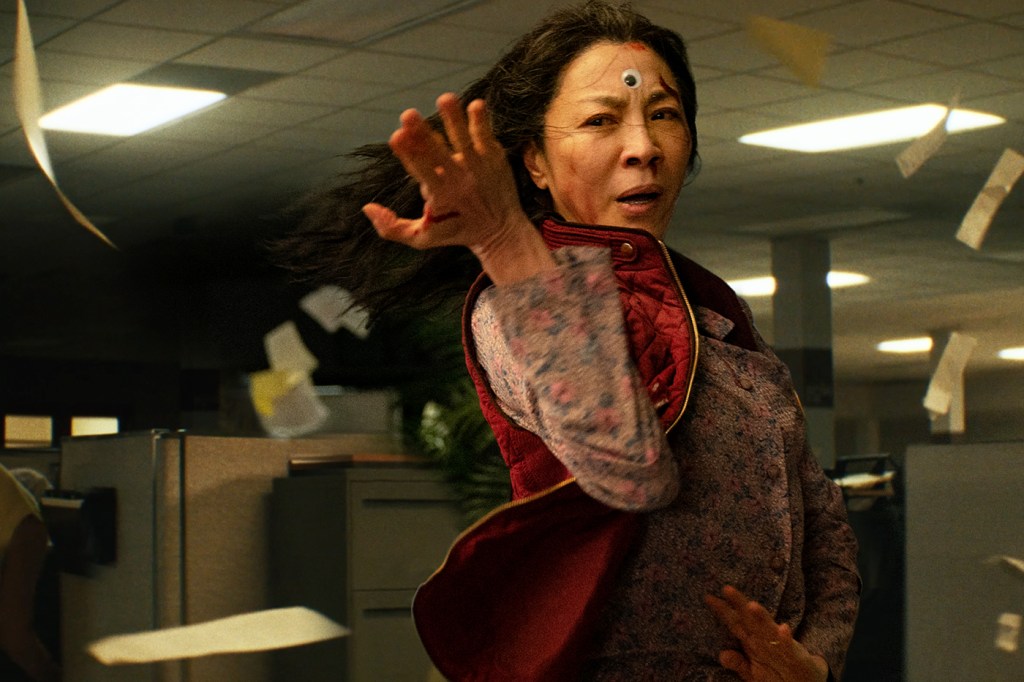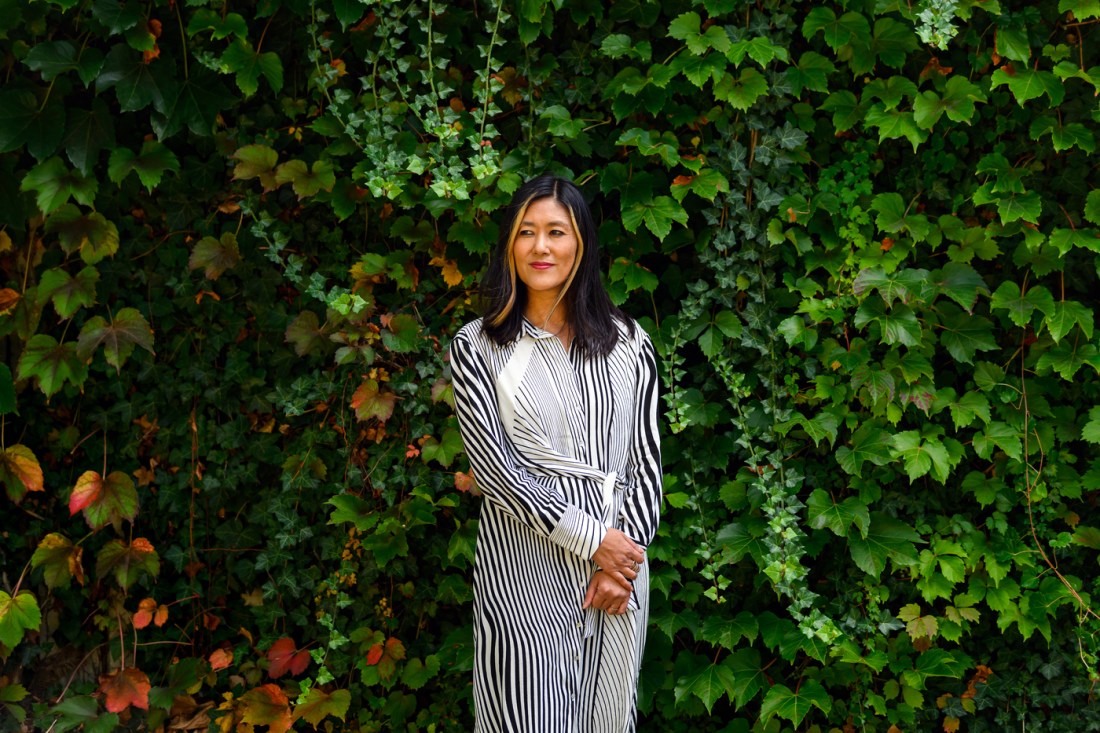A win for ‘Everything Everywhere All at Once’ at the Oscars would be a monumental moment in Hollywood history

Hollywood is gearing up for the 95th Academy Awards this weekend, and all eyes are on “Everything Everywhere All at Once,” the zany, modestly-budgeted but ambitious sci-fi film that has dominated awards season.
Directed by the directing duo known as the Daniels, Daniel Kwon and Daniel Scheiner, the film combines an intergenerational family drama, multiversal science fiction adventure, absurdist comedy and martial arts action. It also stars a majority Asian cast, with Michelle Yeoh, Ke Huy Quan, Stephanie Hsu and James Wong along for the ride, making its 11 Oscar nominations particularly significant.
The success of “Everything Everywhere All at Once,” both at the box office and among awards bodies, is another “breakthrough” in Hollywood’s slow acceptance of Asian and Asian American cinema, says Denise Khor, associate professor of Asian American studies and visual studies at Northeastern University. The film, which centers Evelyn (Yeoh), a Chinese immigrant laundromat owner, and Joy (Hsu), her first generation daughter, and the infinite versions of them throughout the multiverse, has also reignited a conversation about the struggles Asian actors have faced throughout Hollywood history.

“It is very monumental, but why it’s monumental––that conversation that we’re having around the film is a conversation that has been had since the beginning of cinema,” Khor says.
Khor acknowledges Hollywood has made some progress in terms of representing and celebrating Asian cinema in recent years. “Parasite,” a South Korean thriller, won best picture in 2019, and films like the South Korean immigrant drama “Minari” have been nominated for the Oscar’s top prize. And blockbuster films with all Asian casts like “Crazy Rich Asians” and Marvel’s “Shang-Chi and the Legend of the Ten Rings” have made history and proved to executives the viability of big budget productions centered on Asian characters.
But those success stories are still not the norm. In acceptance speeches and press interviews, the cast of “Everything Everywhere All at Once” has been open about their experiences with racism and representation in Hollywood.
Yeoh’s decades-spanning career in Hong Kong and America has made her a cinematic legend, but “Everything Everywhere All at Once” is her first lead role in a Hollywood film. Quan found early success as a child actor in the 1980s in films like “Indiana Jones and the Temple of Doom” and “The Goonies.” After that, despite his best efforts, he struggled to get a job in front of the camera for close to 35 years––until his Oscar-nominated role in “Everything Everywhere All at Once.” Both Yeoh and Quan made history last month to become the first Asian actors to win their respective Screen Actors Guild Awards.
Those barriers and prejudices have been part of Hollywood since its inception, Khor says. In thinking about Yeoh’s late-career recognition, Khor points to Wong Liu Tsong, known professionally as Anna May Wong, as an example of how the industry has, and hasn’t evolved. A “bonafide movie star” who started her career during the silent film era in the 1920s and ended with 60 film credits, Wong had to fight just to work inside the industry she had devoted her life to.
“She left an incredible body of work, she had a really long career, but she was working at a time when yellowface casting practices were very common,” Khor says, referencing the practice of casting white actors in Asian roles. “That industry practice of yellowface has really shaped the roles of Asian American actors working in the industry.”
Wong was infamously passed over for a role in “The Good Earth,” which instead went to Luise Rainer. Eventually, Wong left Hollywood to pursue a career in Europe and the theater.
And when films started using sound, the heavily accented yellow voice, which Hong referenced during a speech at the SAG Awards, emerged.
“It’s not Asians’ actual accents, but it is this sort of made up signifier that really connotes nothing but racial difference,” Khor says. “That imperative that you must perform this yellow voice in order to actually perform your Asian-ness has been something we see time and again in Hollywood.”
“Everything Everywhere All at Once” flips the script on Hollywood’s history of mistreating Asian people, which Khor says has contributed somewhat to the success of the film. The use of Chinglish, a combination of English and Chinese, conveys an authentic, lived experience that feels like “the way that people speak,” she says. And the way the filmmakers turn cultural and linguistic misunderstandings––most notably Evelyn’s misinterpretation of the Pixar film “Ratatouille” as “Raccacoonie”––into jokes with emotional payoffs avoid the sins of the past.
“It seems like there’s a way in which, at least for me as an Asian American, in those moments they’re talking to me,” Khor says. “If you understand the ways in which the accent has been used as a racializing trope, it’s just so clever. Those kinds of moments really puncture and remind us simultaneously of this history while offering us something else.”
The idea that a wacky science fiction film like “Everything Everywhere All at Once,” which includes an extended joke about a universe in which everybody has hot dog fingers, is a frontrunner for best picture is surprising. But who the film centers––both in front of and behind the camera––makes its place in the Oscar race significant.
Hollywood operates on the logic of bankability: Who is most likely to bring in the biggest audience and profits? Historically, executives have answered that question with the Tom Cruises and Harrison Fords of the world, Khor says. In an increasingly risk-averse industry, those decisions have been “determinative of what it is that we see” on screen. That Yeoh, a 60-year-old Asian woman who is legendary to those who know her but who lacks mass recognition, anchors “Everything Everywhere All at Once” pokes holes in traditional Hollywood logic, just like the film itself.
The film’s success at the Oscars isn’t a panacea. There is still plenty of progress to be made. But Khor hopes the potential Oscar-wins for “Everything Everywhere All at Once” and the recent wave of successful Asian-led films will let those in Hollywood know that there is another universe of filmmaking and filmmakers out there––and audiences are craving it.
“The Academy and industry folks are now belatedly recognizing what so many people have already recognized, which is that the cinemas of Asia are incredible,” Khor says. “They have been doing incredible work, and they have deep histories and there are auteurs that have come out of these national cinemas. … In the United States, we’re just the last ones to realize what the hell is up.”
Cody Mello-Klein is a Northeastern Global News reporter. Email him at c.mello-klein@northeastern.edu. Follow him on Twitter @Proelectioneer.






